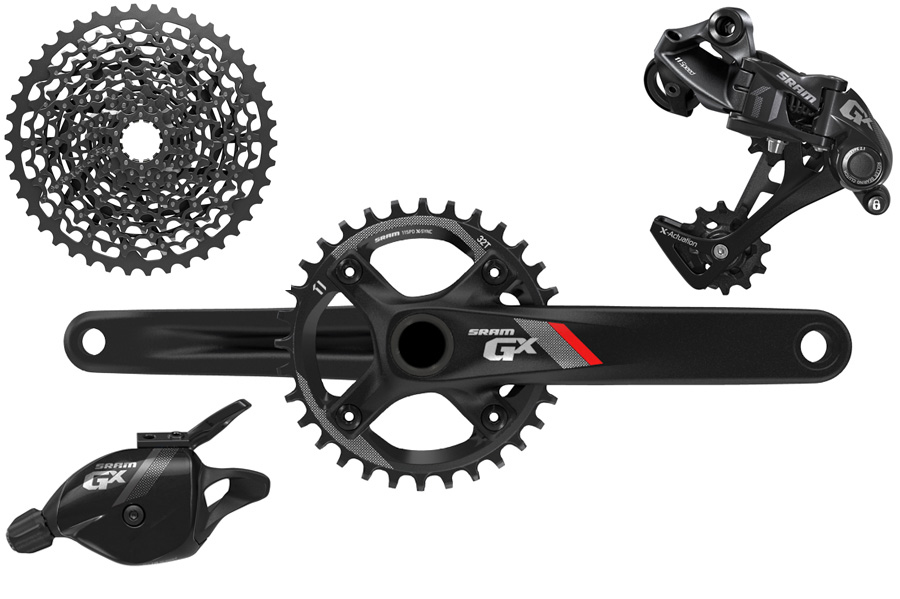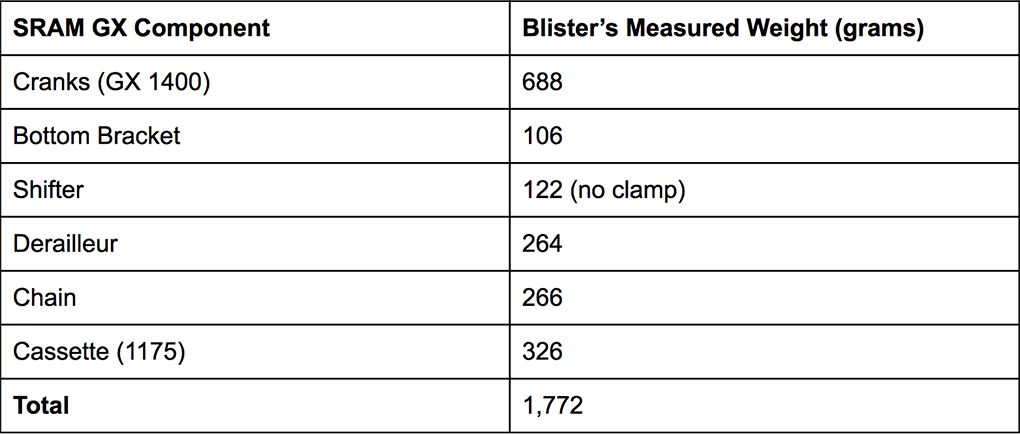
SRAM GX 1×11 Drivetrain
Configuration Tested:
- 175mm Aluminum GX1400 Cranks
- Threaded GXP Bottom bracket
- 32t X-sync chainring
- GX 11 speed trigger shifter
- GX 11 speed X-HORIZON(™) rear derailleur
- GX 1175 11 speed cassette with aluminum 42 tooth cog
- PC-X1 Chain
MSRP: $564 (depending on configuration)
Mounted to: Canfield Yelli Screamy
Days Tested: 20
Test Location: Park City, UT & Jackson, WY
Reviewer: 5’8” 160 lbs
This spring, SRAM released their newest 1X11 drivetrain group: GX.
The $564 GX line is now the least expensive 1×11 offering from SRAM, and comes in well below the X1 system ($970).
This means that it will be spec’d on much less expensive bikes than the X1 group would be, making 1×11 drivetrains accessible to more people. This is a good thing.
If you hadn’t picked up on it before, I’m a big proponent of 1×11 drivetrains. They reduce frustration, increase reliability, and provide sequential shifts, which means that I won’t have to spend my time at the trailhead explaining the problem of cross chaining to new riders I’m taking out.
This is also one of the first kits that is inexpensive enough to tempt riders who have otherwise used add-on cogs with 10 speed cassettes for additional gear range, rather than bumping up to a dedicated 1×11 system.
There’s a 2x Options, Too
The GX drivetrain is also offered in a 2×10 and a 2×11 configuration (with 36/24 rings) for those seeking an extra wide gear range. This configuration includes a 2×11 specific front derailleur, and a more traditional angled body parallelogram configuration rear derailleur instead of the horizontal X-HORIZON(™) used on SRAM’s 1×11 drivetrains.
The 2×11 GX is an option for folks doing mountain bike touring or similar activities that require a wider gear range.
Back to 1×11…
Those of us at Blister have largely agreed that there is little performance lost between X1, XO1, and XX1. For the most part, the only difference is a bit of weight. I was curious to see if the GX line would be able to continue this trend.
Additionally, the GX cassette is the first relatively affordable 11-speed SRAM cassette (X1 costs $315 for a 313g cassette, GX costs $144 for a 394g cassette (the GX 1150)), making it an attractive option for those who have worn out the original cassette on their bike. So I was interested to see if the SRAM GX would be a viable alternative to the X1 cassette, since the cost savings are huge.
The Build
The SRAM GX drivetrain is available with either gripshift or trigger shifters, the 1150 steel 10-42T cassette or the 1175 steel/aluminum 10-42T cog cassette, and GX 1400 hollow aluminum cranks with removable spider or GX 1000 solid aluminum, 4 arm cranks.
SRAM GX Weights:
Cranks: The cranks come it a 688g without a bottom bracket (8g over list weight, not bad) and switching to a direct mount chainring can save 70 grams (32t ring with 94mm BCD spider – 124g, 32t direct mount ring – 54g). These have a great price to weight ratio at $195 (GX 1000 is $149). With the spider the smallest ring you can run is 30t. With an X-SYNC(™) direct mount ring you can go down to 26t. These cranks are available in a wide range of configurations including boost, so you are likely to find a set to match any bike you have.
Shifter: The shifter weighs 122g and looks quite similar to the SRAM X1 shifter. I couldn’t distinguish any differences.
Rear Derailleur: The rear derailleur weighs 264g. It isn’t entirely intuitive, so note when assembling that the cable routing should look like this:

Chain: The chain is the same chain used for the X1 drivetrain. The weight is 266g (uncut).
Cassette: The cassette is a pretty nice looking piece, with tooth sculpting and lots of shaping for weight loss. It weighs 326g on my scale, only ~10g heavier than X1. Most articles and press releases have listed a 394g weight, but I believe that is for the heavier all steel GX 1150 cassette. I have the GX 1175 cassette with the aluminum 42T cog, but SRAM has not published a price for this yet.
Assembly went pretty easily, with no unexpected surprises. Just note the correct cable routing when you install the derailleur.
Adding everything up, I get a total kit weight of 1,772g. That’s pretty solid, just 39g more than X1, and $360 cheaper as configured for our test. (It’s possible that the price difference might be a bit reduced, depending on how SRAM ends up pricing the 1175 cassette).
NEXT: Construction, The Ride, etc.


Awesome review! I’m still on a 3×9 =( this may finally be cheap enough for me to switch. (On a serious note should probably save for a new bike now)
Thanks Yuhao! It is always a tough call when to upgrade and when to move on to a new bike. I wish you the best of luck with the decision!
The rear derailleur is still $110. Considering I go through around 2-3 rear derailleurs per season, the $35 Deore M615 derailleur is fine by me. $330 vs $105 is a no-brainer.
Manual 2×10 with a 30/36 chainrings and 11-40 OneUp seems to be working just fine for me – even when hitting the double-blacks at the bike park (no chain guide needed yet).
Lindahl,
It is great to hear of unique setups. I went through a long period where I tore apart rear derailleurs with some frequency. I also ran $35 Deore rear derailleurs during that time. They offer a great value for the price.
Hi Tom,
Thank you for the first proper review of the GX drive train.
It was sad to read that it’s the first 11 group that trickled down performance from the Sram lineup since I had big hopes for it to make me change my 2×10 setup.
Therefore I can’t wait no longer so I want to make the jump for 1x system so what do you think, if I’m gonna take all the package from Gx except the rear derailleur (I would get the X1) will it perform mostly like the upper in Sram’s lineup with no flaws?
By the way, have anyone noticed if you flip ” X9″ 180 degrees you get a GX? It could make sense in some ways.
Hi Bogdan,
I’d still take GX over any 2×10 setup and I’m still happily using the setup I reviewed. I do think that upgrading to an X1 rear derailleur will likely improve performance and it will definitely improve durability. It should perform mostly like the upper SRAM lineup and will definitely be a step up from 2×10. Make sure that you get an XD hub driver too.
Interesting observation. I hadn’t noticed that.
-Tom
I’m interested in this system. Right now I’m running SRAM X9 on the rear drivetrain. How does GX compare to that?
I haven’t run X9 since 2012, but I do feel strongly that 1×11 is superior to 2×10 and GX is better than X9 from 2012.
-Tom
Hi tom. Excellent review. Thank you!
I’m currently running XT 2×10. Drive train is shot so time to replace/upgrade.
I’m very interested in the GX. How would you say it compares to shimanos new 1×11 xt?
Mike,
It comes down to ergonomics for me. You will likely either prefer the dual-direction, dual downshift Shimano levers or the SRAM levers.
The XT system also might be more durable, but the difference isn’t significant.
I prefer the GX system, but I’m sure many people prefer the XT system.
hi Tom,
how do you compare the 11speed GX and XT M8000 shifter and derailleur. which is which in terms of performance?
Tomas,
Take a look at my Shimano review http://blistergearreview.com/gear-reviews/shimano-xt-11-speed-drivetrain
I cover that question there.
Hi Tom!!
That’s one of the best 1×11 drivetrain reviews I’ve read!
Recently bought a Sram Gx 1×11 system with an XX1 crankset.Firtsly everything was smooth and quite but after a short period,shifting performance yield fell and chain start bouncing a lot but hopefully dont get of the chainring.
I will sent it back for inspection and propably I will buy a new X1 or X01 fore better performance.Maybe I’ll change and the shifter too if bad shifting continuous.My previous 1×10 x9 with 42 cassette cog set up was perfect.
Hi Nick,
Thanks for the kind words. Your problem sounds like it was probably caused by of one of the following: bent component, worn cassette/chainring, or misadjustment. Recognize I’m just hearing your problem from the other side of the internet so there are almost certainly details I’m missing. I hope the inspection solves your problems.